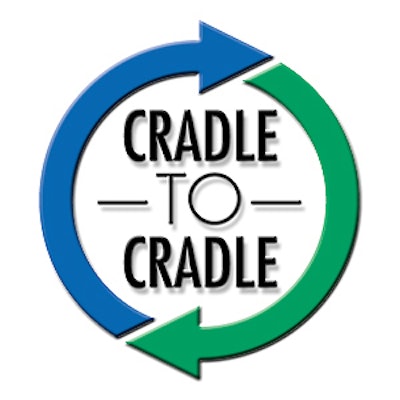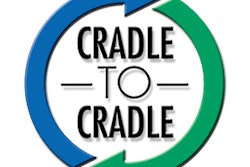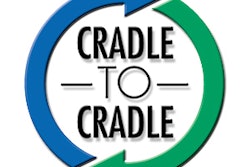How’s this for an environmental packaging strategy?
• Use more packaging material, not less.
• Instead of designing with the cheapest materials, design the best package possible, without worrying about per-package cost.
• “Littering” can help the environment.
Sound politically incorrect, and financially suicidal? Take a closer look. What if that ice cream wrapper lying on the side of the road were designed to “melt” into a biosafe liquid in a matter of hours at ambient temperatures? What if the foam food container was not only biodegradable, but incorporated essential nutrients to replenish the topsoil?
What if there were such a thing as fifth-class postage that existed solely for the purpose of returning packaging to the manufacturer? Instead of buying the cheapest possible packaging, you buy the best possible packaging because you are getting most of it back. And guess which package looks better on the shelf as a result?
Extreme? Yes. Possible? Only time will tell.
It’s all part of a new way of product and package design, called cradle-to-cradle design.
By contrast, traditional cradle-to-grave design practically guarantees a product or package will end up as unwanted waste that must be dealt with at some cost to the end user. Plus, the manufacturer loses the economic value of reusing the material, because it’s on a one-way trip out of the factory.
Technical and biological nutrients
Cradle-to-cradle design means literally designing waste right out of the lifecycle of the package. Mimicking nature, a package is designed to be either a technical nutrient that can be reused, or truly recycled in a tight, closed-loop process with zero loss in material performance, or a biological nutrient that can safely break down into the soil (see illustration, opposite page).
The originators of this concept, architect William McDonough and chemist Michael Braungart, recently published a book on the subject called Cradle to Cradle: Remaking the Way We Make Things. The authors’ design consultancy, McDonough Braungart Design Chemistry (MBDC), has worked with companies like Ford Motor Co., Nike, Herman Miller, and BASF to help redesign their products using the cradle-to-cradle concept. Though the authors have done a few packaging projects, their design concept is essentially brand new—and untested—in the field of packaging.
However, packaging is an area that’s well suited to the cradle-to-cradle design concept, the authors say. They contend that cradle-to-cradle design has the potential to expand, not reduce, the choices of materials available to package designers. They say packaging can be designed to be an asset after use, rather than a liability, for customers. Finally, they argue that cradle-to-cradle packaging can cost the same or less than the packaging it replaces.
Instead of focusing on the moral argument, which traditionally pits environmentalism against business interests, the authors have made a compelling business argument for ecologically “intelligent” products and packaging that are also good for the bottom line.
We asked the authors, in a series of exclusive interviews, to flesh out their vision for how cradle-to-cradle design might play out in packaging.
No more ‘ugly’ packaging
McDonough and Braungart frown on what they term eco-efficient packaging, with its traditional focus on making packaging merely less damaging to the environment. For example, a bottle with recycled content is still headed on a one-way trip to a landfill, unless a consumer happens to recycle it.
Instead, the authors favor eco-effective packaging, which is designed at the outset to travel in either a biological or technical closed loop.
“For me, packaging is far too important to make it merely efficient,” says Braungart. In other words, the trade-off associated with traditional eco-efficient packaging—duller colors and reduced performance characteristics—is not only not worth it, it’s unnecessary, Braungart maintains.
What stands in the way of true closed-loop recycling, according to Braungart, is not the materials themselves—it’s often the additives and inks, which were never designed or selected with closed-loop recyclability in mind. The result is that “you are highly limited in the next use of that material,” says Braungart. “If you mix all these different types of additives, you always end up with downcycling.” In other words, a park bench instead of a pop bottle.
Instead, package designers can still use the same materials they’re using now, but positively select the ingredients of that material for recyclability. That could mean a 100% post-consumer-recycled (PCR) package that looks and prints as good as new. “We have been testing polymers that can be reused up to 90 times with the same performance characteristics,” says Braungart.
It’s not just about plastic—paper-based packaging can be designed this way too. “If you design inks in a way that you can wash them out, then you get white paper again,” says Braungart.
Or instead of becoming a technical nutrient, a package can be designed to be a biological one. “As soon as you add more than 35% linear polyesters to PET, the whole material becomes biodegradable,” says Braungart.
“I’m saying we should design for reincarnation,” says Braungart. “You plan the next use of the material into the package already.”
Reusability saves
The notion of reusable packaging is a big potential part of the cradle-to-cradle vision. “Today, packaging needs to be cheap, which limits the designer’s possibilities,” says Braungart. Viewing packaging as a technical nutrient that can be reused “means you can use far more valuable and expensive materials,” he says. This hinges, of course, on the cost-effective recovery of those materials.
William McDonough says some packaging, such as for consumer electronics, is ripe for return, via, say, fifth-class postage.
“There’s no reason we can’t create it,” says McDonough. “That can be our recycling system. We say to FedEx, UPS, the postal service, look, you guys have trucks moving around—they come full, they leave empty. How about they come full, they leave full? What you do is you just make it lowest priority. Nobody thinks about the positive aspects of low priority. Any postage truck that’s driving around empty at end of day is suboptimal. You’re driving air around.”
How to handle returnability for a package that’s been contaminated by the product? “Procter & Gamble may not be able to reuse that package,” acknowledges McDonough, “but BASF could use that polymer. So it might list BASF’s return address instead of Procter & Gamble’s.”
Adds Braungart: “You can give your customers a choice. ‘Here’s the eco-efficient ugly, cheap package; and here’s the nice package that you’d like to see in your bathroom, but it’s so valuable that we’d like to have it back.’”
Of course, returnable packaging has shown steady growth over the last few years for industrial applications. Manufacturers streamlining their supply chains find it’s easier to coordinate closed-loop package use-and-return systems when there’s only a handful of vendors or customers involved.
But returnable consumer packaging is quite another story. Back in 1960, of course, 95% of soft drink containers were refillable glass bottles. However, today, that number is less than half a percent, according to the Container Recycling Institute.
Why did the beverage industry move away from returnable packaging? Several reasons. One was the development of the recyclable aluminum can in 1962. Another was labor costs, particularly the teamsters who operated the trucks that delivered product to the stores. Further, retailers didn’t like committing valuable space to returned containers awaiting pickup, nor did they like the labor involved in making refunds. And bottling plants didn’t like the space, labor, and energy required for bottle sanitizing systems. In the end, it was cheaper for the industry to switch to one-way packaging, which it did.
So though the notion of returnable consumer packaging is intriguing, there’s quite a history that would have to be overcome to make it a reality for most packagers.
Recycling varies
McDonough and Braungart’s notion of closed-loop biological and technical nutrient streams depends upon the existence of robust recycling and composting infrastructures. But recycling is inherently a local issue—recycling infrastructures can vary widely from one municipality to the next. Municipal composting is far from widespread, and returnable packaging infrastructures in this country are all but nonexistent, except in states with bottle deposit bills. Finally, getting consumers to figure out which type of material goes into which recycle bin is no easy task.
One municipality that seems to have hit on a viable recycling/composting collection infrastructure is San Francisco, according to MBDC’s Joe Rinkevich. In that city’s Fantastic Three program, all recyclables go into one recycling bin, sparing residents the burden of sortation. All organic waste such as food scraps goes into a second bin. Everything else goes into a third bin, whose contents are landfilled. Residents only pay for the waste they put in the third bin, thus creating a financial incentive to use the first two bins.
Both authors contend great strides have been made in sortation technology. “In Europe, the green dot system has generated a lot of separation techniques,” says Braungart, who is German.
Regulation has long been a way to force packagers and their suppliers to take the environment into account when designing their packaging. Producer-responsibilty laws on the books in Europe and elsewhere are a prime example. When asked if he supports the creation of an eco-tax that subsidizes eco-effective packaging at the expense of noneco-effective packaging, McDonough replied, “It would certainly help. But I don’t think it’s essential. That’s a cultural question that will play itself out in the political arena.”
Indeed, in their book, McDonough and Braungart view regulation as a failure of design: “In a world where designs are unintelligent and destructive, regulations can reduce immediate deleterious effects. But ultimately a regulation is a signal of design failure...good design can require no regulation at all.”
Waste to energy
If a package can be safely burned as fuel, that’s another way it can end up as a biological nutrient. Trouble is, most packaging was never designed for burning. Again, additives in the package, such as heavy metals in printing inks, that are released during incineration require expensive filtration technology that eats into the economic value of packaging as a fuel.
In countries where packaging waste is burned for fuel, Braungart says such packaging could be designed for clean burning. This can also be a financial benefit to, say, blow molders, who already find themselves manufacturing bottles on razor-thin margins. Trimmings and scrap take on new value because “you can generate your own energy from the waste that you have without needing several filters” required for conventional packaging.
Comes down to cost
For most packaging users and suppliers—and consumers, for that matter—cost outweighs the environment as a purchasing factor. But the authors insist eco-effective packaging can be the same or cheaper compared to traditional packaging. That’s one of the most important arguments in the cradle-to-cradle zeitgeist, yet it’s the hardest one to prove, because the idea is still so new. And it runs contrary to the industry’s experience with most new forms of, say, biodegradable packaging, which typically cost more, not less, than traditional materials.
Some of the basic arguments run like this: Returnable packaging is much more expensive to initially buy, but a much lower quantity needs to be purchased compared to one-way packaging. Or the raw ingredients, such as the resin, of eco-effective packaging may cost more; but by carefully selecting the additives in the material, the material could be cheaper to manufacture or recycle into a package again, lowering or containing overall costs.
Braungart even suggests that eco-effective packaging can increase brand loyalty, possibly reducing marketing costs. That is, a consumer who can return, recycle or compost a package now becomes a crucial part of the cradle-to-cradle lifecycle, and is presumably won over by the brand’s lack of a disposal burden. “If your customer becomes your partner, you don’t need to repeatedly convince him to use your product,” says Braungart.
The authors contend that companies who have redesigned their products based on the cradle-to-cradle concept have done so at the same or less cost. They argue packaging should be no different.
Too utopian? McDonough and Braungart are unapologetic. They freely admit the cradle-to-cradle design philosophy is not a magic bullet or even a solution. They see it as a roadmap for manufacturers to take their packaging in a completely different direction.
“It’s going to take a while,” McDonough admits. “But it doesn’t mean you can’t start down that path and put that forth as your vision. At least you have a vision instead of no vision. At least you have a strategy instead of no strategy.”
For more on the book, see: packworld.com/go/w067
Visit packworld.com/go/w068 for a more complete list of recent enviro-packaging developments including links to the above items.
See sidebar to this article: Call for entries: better e-commerce packs



























